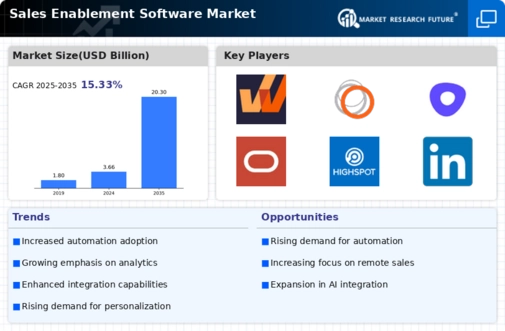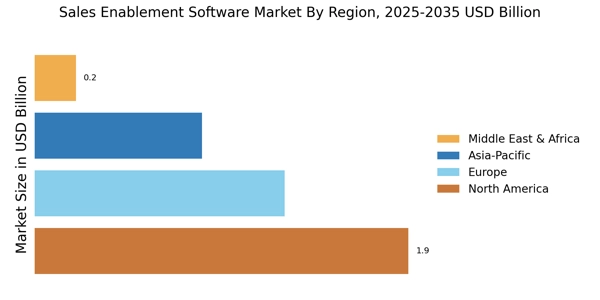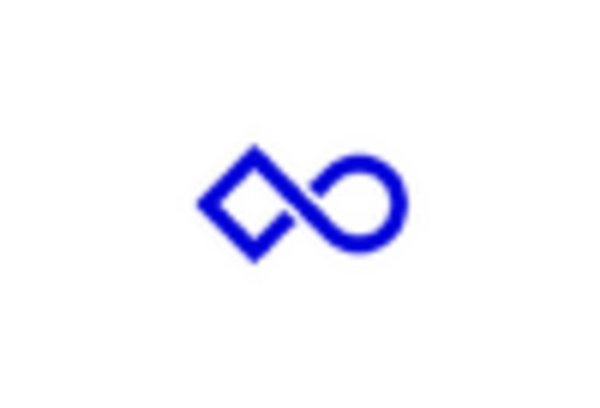Rising Demand for Sales Efficiency
The Sales Enablement Software Market is experiencing a notable surge in demand as organizations increasingly prioritize sales efficiency. Companies are recognizing the need to streamline their sales processes to enhance productivity and drive revenue growth. According to recent data, organizations that implement sales enablement solutions report a 20% increase in sales productivity. This trend is likely to continue as businesses seek to optimize their sales strategies and improve overall performance. The integration of advanced analytics and reporting tools within sales enablement software further supports this drive for efficiency, enabling sales teams to make data-driven decisions. As a result, the Sales Enablement Software Market is poised for substantial growth, with an increasing number of companies investing in these solutions to gain a competitive edge.
Integration of Advanced Technologies
The Sales Enablement Software Market is increasingly characterized by the integration of advanced technologies such as artificial intelligence and machine learning. These technologies are transforming how sales teams operate by automating routine tasks, providing predictive analytics, and enhancing customer engagement. For instance, AI-driven sales enablement tools can analyze customer data to identify potential leads and recommend personalized content, thereby improving the sales process. The adoption of such technologies is projected to grow, with a significant portion of sales teams expected to utilize AI-driven solutions by 2026. This technological evolution is likely to reshape the Sales Enablement Software Market, making it imperative for organizations to adopt innovative solutions to remain competitive.
Increased Focus on Training and Development
The Sales Enablement Software Market is witnessing a heightened focus on training and development initiatives. Organizations are increasingly investing in sales enablement solutions that provide comprehensive training resources to equip their sales teams with the necessary skills and knowledge. This trend is driven by the recognition that well-trained sales personnel are more effective in engaging customers and closing deals. Research indicates that companies with structured training programs see a 50% increase in sales performance. As a result, sales enablement software that offers training modules, onboarding resources, and continuous learning opportunities is gaining traction. This emphasis on training not only enhances individual performance but also contributes to the overall success of the Sales Enablement Software Market.
Shift Towards Remote Sales Enablement Solutions
The Sales Enablement Software Market is adapting to the shift towards remote work and virtual sales environments. As organizations embrace remote sales strategies, the demand for sales enablement software that supports virtual collaboration and communication is on the rise. Tools that facilitate remote training, virtual meetings, and collaborative content sharing are becoming essential for sales teams operating in a distributed environment. Recent surveys indicate that over 70% of sales professionals prefer using digital tools for collaboration, highlighting the need for effective remote sales enablement solutions. This shift is likely to drive innovation within the Sales Enablement Software Market, as vendors develop features tailored to the unique challenges of remote sales.
Growing Importance of Data-Driven Decision Making
In the Sales Enablement Software Market, the emphasis on data-driven decision making is becoming increasingly pronounced. Organizations are leveraging sales enablement tools to gather and analyze data related to customer interactions, sales performance, and market trends. This analytical approach allows sales teams to tailor their strategies based on real-time insights, leading to improved outcomes. Recent statistics indicate that companies utilizing data analytics within their sales processes experience a 15% higher win rate compared to those that do not. As businesses continue to recognize the value of data in shaping their sales strategies, the demand for sales enablement software that offers robust analytics capabilities is expected to rise. This trend underscores the critical role of data in driving success within the Sales Enablement Software Market.


















Leave a Comment